Critical Analysis of a Humanitarian Intervention Evaluation Report
Added on 2021-05-31
19 Pages4235 Words378 Views
Running Head: CRITICAL ANALYSIS OF DFAT’S REPORT 0A critical analysis of a Humanitarian InterventionEvaluation ReportStudent Name

CRITICAL ANALYSIS OF DFAT’S REPORT 1Table of ContentsIntroduction................................................................................................................................2Some of the other studies conducted by different organisations are......................................3Purpose and rationale for the evaluation....................................................................................4Methodology used in the evaluation..........................................................................................4Document Review..................................................................................................................4Key Informant Interviews......................................................................................................5FGD (Focused Group Discussion).........................................................................................5Values and Principle..................................................................................................................5Strength and limitations.............................................................................................................6Strengths.................................................................................................................................6Limitation...............................................................................................................................6What Data collected and its appropriateness.............................................................................7NGO’s and other organisation involved in evaluation and their capacity.................................7Criteria used to evaluate actions and achievements...................................................................8How its approach differed from that suggested by other society’s framework.........................8DFAT evaluation approaches.................................................................................................8How it’s approach different from IFRS and RCS’s framework............................................9Health featured in evaluation...................................................................................................10Appropriateness of findings.....................................................................................................11Conclusion................................................................................................................................12References................................................................................................................................14

CRITICAL ANALYSIS OF DFAT’S REPORT 2A critical analysis of a humanitarian intervention evaluation reportIntroductionDepartment of foreign affairs and trade released a document to evaluate the human interventions provided and how well Australian government responded to that situation during a cyclone pam hit Vanuatu Country. This article was published in 2017 by DFAT, Canberra. On 13 March 2015 tropical cyclone struck many areas of Vanuatu with wind speedof 270 km/h (Hong et al., 2018). According to Magee, Danielle, Verdon-Kidd, Kiem and Royle (2015), it was the most disastrous cyclone ever faced in history. As discussed in DFATevaluation report this cyclone pam affected most of the population and damaged 90% of the infrastructure. The destruction impacts all of the areas like agriculture, education, health facilities, private property etc. It was estimated that around half of people were faced adverse situation because of this cyclone. Thousands of people displaced internally, high number people had no place to live and were searching for shelter. At that time Vanuatu government had limited resources and money to overcome this situation so they asked for help to all courtiers and they received help from all over the globe, but Australia was the first nation responded quickly to support people who were in trouble. According to news published by Ministry for Foreign Affairs (2018) Julie Bishop (Minister of foreign affairs) announced to provide financial help of $300,000 especially for people with disabilities. New Zealand announced financial help of NZ$ 2.5 million (Hayward-Jones, 2015). Australian government and other departments sanctioned more than $15 million to recover from negative impacts occurred due to cyclone. Military assistance also provided relief services the people of Vanuatu (Bergin, 2015).Various other organisations like the Australian Red Cross, Red Crescent and other

CRITICAL ANALYSIS OF DFAT’S REPORT 3private sectors also helped financially to support to Vanuatu government. This article analysed effectiveness of services provided to the cyclone affected people and humanitarian intervention evaluation report will be analysed critically. Methods, purposes, criteria used, appropriateness of the findings and how different these were from services provided with other organisation, will be discussed by reviewing the report of DFAT and other various reports. It will also be analysed that whether the intervention mentioned in that document were up to the mark or not. Some of the other studies conducted by different organisations are:UNICEF (2016) conducted a review article after six months of cyclone hit Vanuatu. Some key findings of that study are:It was the biggest cyclone ever recorded.The pre-planned strategies to face cyclone were not enough in Vanuatu and Fuji. The interventions provided to the cyclone affected people were quick. Level 2 procedure were not used properly because of this the funding was not processed on time and some of the opportunities missed.The management roles within UNICEF pacific were not clear.Strong relationship has been built by UNICEF with partner service providers. A study conducted by Handmer and Iveson (2017) stated that people of Vanuatu warned on time by using text , mobile phones etc. and it was found that text messages were more effective to send warnings of cyclone pam within a population, and this becomes the reason of low deaths occurred. Local people were alerted by youth (Ray, De, Leone, & Gilbert, 2017).

End of preview
Want to access all the pages? Upload your documents or become a member.
Related Documents
Evaluation of Australian Red Cross Humanitarian Partnership 2015-19lg...
|9
|2247
|145
Critical Analysis of an Evaluation Essaylg...
|14
|4015
|273
Report on the IFRC Framework 5 International Federation of Red Cross and Red Crescent Societieslg...
|11
|3669
|93
A Critical Analysis of a Humanitarian Interventionlg...
|16
|4256
|77
Assessment 1 Critical Appraisal Literature Reviewlg...
|7
|1971
|390
Report on Search Methodlg...
|8
|1632
|214
